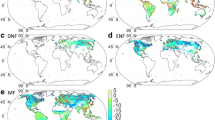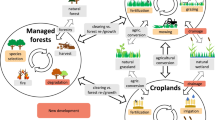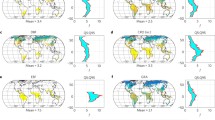Abstract
We demonstrate the effectiveness of a new method for quantifying radiative forcing from land use and land cover change (LULCC) within an integrated assessment model, the Global Change Assessment Model (GCAM). The method relies on geographically differentiated estimates of radiative forcing from albedo change associated with major land cover transitions derived from the Community Earth System Model. We find that conversion of 1 km2 of woody vegetation (forest and shrublands) to non-woody vegetation (crops and grassland) yields between 0 and −0.71 nW/m2 of globally averaged radiative forcing determined by the vegetation characteristics, snow dynamics, and atmospheric radiation environment characteristic within each of 151 regions we consider globally. Across a set of scenarios designed to span a range of potential future LULCC, we find LULCC forcing ranging from −0.06 to −0.29 W/m2 by 2070 depending on assumptions regarding future crop yield growth and whether climate policy favors afforestation or bioenergy crops. Inclusion of this previously uncounted forcing in the policy targets driving future climate mitigation efforts leads to changes in fossil fuel emissions on the order of 1.5 PgC/yr by 2070 for a climate forcing limit of 4.5 Wm−2, corresponding to a 12–67 % change in fossil fuel emissions depending on the scenario. Scenarios with significant afforestation must compensate for albedo-induced warming through additional emissions reductions, and scenarios with significant deforestation need not mitigate as aggressively due to albedo-induced cooling. In all scenarios considered, inclusion of albedo forcing in policy targets increases forest and shrub cover globally.






Similar content being viewed by others
Notes
The IAMs used to generate the RCPs do include radiative forcing from historic albedo change. However, this forcing is held constant at −0.2 W/m2 throughout the 21st century, regardless of future LULCC. For the RCPs, this historic albedo forcing was not included in the totals reported or used to drive the internal climate policies.
We focus our analysis on the year 2070 in part because the GCAM model exhibits non-convergent behavior beyond this point for the FFICT scenarios See Calvin et al. (2014) for a description of this phenomenon.
References
Anon (2005) Radiative forcing of climate change: expanding the concept and addressing uncertainties. National Acad Sciences. [online] Available from: http://www.nap.edu/openbook.php?record_id=11175
Arora VK, Montenegro A (2011) Small temperature benefits provided by realistic afforestation efforts. Nat Geosci 4:514–518
Bala G, Caldeira K, Wickett M et al (2007) Combined climate and carbon-cycle effects of large-scale deforestation. Proc Natl Acad Sci 104:6550
Ban-Weiss GA, Cao L, Bala G, Caldeira K (2011) Dependence of climate forcing and response on the altitude of black carbon aerosols. Climate Dynam 38:897–911. doi:10.1007/s00382-011-1052-y
Betts R (2000) Offset of the potential carbon sink from boreal forestation by decreases in surface albedo. Nature 408:187–190
Bonan G (2008) Forests and climate change: forcings, feedbacks, and the climate benefits of forests. Science 320:1444–1449. doi:10.1126/science.1155121
Brovkin V, Boysen L, Arora VK et al (2013) Effect of anthropogenic land-use and land-cover changes on climate and land carbon storage in CMIP5 projections for the twenty-first century. J Climate 26:6859–6881. doi:10.1175/JCLI-D-12-00623.1
Caiazzo F, Malina R, Staples MD et al (2014) Quantifying the climate impacts of albedo changes due to biofuel production: a comparison with biogeochemical effects. Environ Res Lett 9:024015. doi:10.1088/1748-9326/9/2/024015
Calvin K, Clarke L, Edmonds J, Eom J, Hejazi M, Kim S, Kyle P, Link R, Luckow P and Patel P (2011) “GCAM Wiki Documentation.” from https://wiki.umd.edu/gcam/
Calvin K, Wise M, Clarke L et al (2014) Near-term limits to mitigation: challenges arising from contrary mitigation effects from indirect land-use change and sulfur emissions. Energy Econ 42:233–239. doi:10.1016/j.eneco.2013.09.026
Conley AJ, Lamarque JF, Vitt F et al (2013) PORT, a CESM tool for the diagnosis of radiative forcing. Geosci Model Dev 6:469–476
Davies-Barnard T, Valdes PJ, Singarayer JS, Jones CD (2014) Climatic impacts of land-use change due to crop yield increases and a universal carbon Tax from a scenario model. J Climate 27:1413–1424
Edmonds J, Wise M (1999) Exploring A Technology Strategy for Stabilizing Atmospheric CO2. International Environmental Agreements on Climate Change, Kluwer Academic Publishers 131–154
Feddema JJ, Oleson KW, Bonan GB et al (2005) The importance of land-cover change in simulating future climates. Science 310:1674–1678. doi:10.1126/science.1118160
Foley J, DeFries R, Asner G, Barford C (2005) Global consequences of land use. Science 309:570–574
Hallgren W, Schlosser CA, Monier E et al (2013) Climate impacts of a large-scale biofuels expansion. Geophys Res Lett 40:1624–1630. doi:10.1002/grl.50352
Hurrell JW, Hack JJ, Shea D et al (2008) A new sea surface temperature and sea ice boundary dataset for the community atmosphere model. J Climate 21:5145–5153
Hurrell JW, Holland MM, Gent PR et al (2013) The community earth system model: a framework for collaborative research. Bull Am Meteorol Soc 94:1339–1360
Iacono MJ, Delamere JS, Mlawer EJ et al (2008) Radiative forcing by long-lived greenhouse gases: calculations with the AER radiative transfer models. J Geophys Res 113:D13103
Jones AD, Collins W, Edmonds J et al (2013a) Greenhouse gas policies influence climate via direct effects of land use change. J Climate 26:3657–3670. doi:10.1175/JCLI-D-12-00377.1
Jones AD, Collins WD, Torn MS (2013b) On the additivity of radiative forcing between land use change and greenhouse gases. Geophys Res Lett 40:4036–4041. doi:10.1002/grl.50754
PJ, Chase TN (2007) Representing a new MODIS consistent land surface in the Community Land Model (CLM 3.0). J Geophys Res 112:G01023. doi:10.1029/2006JG000168
Lawrence DM, Oleson KW, Flanner MG et al. (2011) Parameterization improvements and functional and structural advances in Version 4 of the Community Land Model. J Adv Model Earth Syst. 3:1–27. doi: 10.1029/2011MS000045
Lee H-L, Hertel T, Sohngen B, Ramankutty N (2005) Towards an integrated land use data base for assessing the potential for greenhouse gas mitigation. GTAP Technical Papers 25. 1–83. https://www.gtap.agecon.purdue.edu/resources/res_display.asp?RecordID=1900
Meinshausen M, Raper S, Wigley T (2011) Emulating coupled atmosphere–ocean and carbon cycle models with a simpler model, MAGICC6–Part 1: Model description and calibration. Atmos Chem Phys 11:1417–1456
Mitchell TD (2003) Pattern scaling: an examination of the accuracy of the technique for describing future climates. Clim Change 60:217–242. doi:10.1023/A:1026035305597
Monfreda C, Ramankutty N, Hertel TW (2009) Global agricultural land use data for climate change analysis. In: Hertel T, Rose S, Tol R (eds) Economic analysis of land use in global climate change policy. Routledge, UK
Park S, Bretherton CS, Rasch PJ (2014) Integrating cloud processes in the community atmosphere model, version 5. J Climate 27:6821–6856. doi:10.1175/JCLI-D-14-00087.1
Pielke R Sr, Marland G, Betts R et al (2002) The influence of land-use change and landscape dynamics on the climate system: relevance to climate-change policy beyond the radiative effect of greenhouse gases. Philos Trans R Soc 360:1705–1719
Pongratz J, Reick CH, Raddatz T, Claussen M (2010) Biogeophysical versus biogeochemical climate response to historical anthropogenic land cover change. Geophys Res Lett. doi:10.1029/2010GL043010
Pongratz J, Reick CH, Raddatz T et al (2011) Past land use decisions have increased mitigation potential of reforestation. Geophys Res Lett 38:L15701
Stocker TF, Qin D, Plattner GK et al (2013) IPCC, 2013: Climate Change 2013: the physical science basis. Contribution of working group I to the fifth assessment report of the intergovernmental panel on climate. Cambridge University Press, Change
Taylor KE, Stouffer RJ, Meehl GA (2012) An overview of CMIP5 and the experiment design. Bull Am Meteorol Soc 93:485–498
Tebaldi C, Arblaster JM (2014) Pattern scaling: its strengths and limitations, and an update on the latest model simulations. Clim Change 122:459–471. doi:10.1007/s10584-013-1032-9
Thomson AM, Calvin KV, Smith SJ et al (2011) RCP4. 5: a pathway for stabilization of radiative forcing by 2100. Clim Change 109:77–94
van Vuuren DP, Edmonds J, Kainuma M et al (2011) The representative concentration pathways: an overview. Clim Change 109:5–31. doi:10.1007/s10584-011-0148-z
Wise M, Calvin K, Thomson A et al (2009) Implications of Limiting CO2 Concentrations for Land Use and Energy. Science 324:1183–1186. doi:10.1126/science.1168475
Wise M, Calvin KV, Kyle P et al (2014) Economic and physical modeling of land Use in GCAM 3.0 and an application to agricultural productivity, land, and terrestrial carbon. Clim Change Econ 05:1450003. doi:10.1142/S2010007814500031
Acknowledgments
This research was supported by the Office of Science of the U.S. Department of Energy as part of the Improving the Representations of Human-Earth System Interactions Project. This work used the Community Earth System Model, CESM and the Global Change Assessment Model, GCAM. The National Science Foundation and the Office of Science of the U.S. Department of Energy support the CESM project. The authors acknowledge long-term support for GCAM development from the Integrated Assessment Research Program in the Office of Science of the U.S. Department of Energy. This research used resources of the National Energy Research Scientific Computing Center, which is supported by the Office of Science of the U.S. Department of Energy under Contract No. DE-AC02-0 5CH11231. Battelle Memorial Institute operates the Pacific Northwest National Laboratory for DOE under contract DE-AC06-76RLO 1830. Lawrence Berkeley National Laboratory is supported by the U.S. Department of Energy under Contract No. DE-AC02-0 5CH11231.
Author information
Authors and Affiliations
Corresponding author
Additional information
Andrew D. Jones and Katherine V. Calvin contributed equally to this work.
Rights and permissions
About this article
Cite this article
Jones, A.D., Calvin, K.V., Collins, W.D. et al. Accounting for radiative forcing from albedo change in future global land-use scenarios. Climatic Change 131, 691–703 (2015). https://doi.org/10.1007/s10584-015-1411-5
Received:
Accepted:
Published:
Issue Date:
DOI: https://doi.org/10.1007/s10584-015-1411-5




